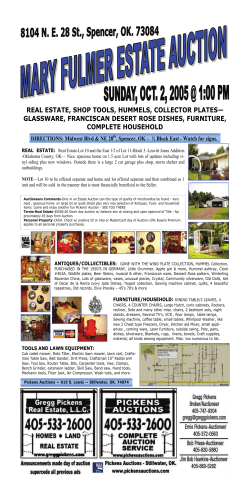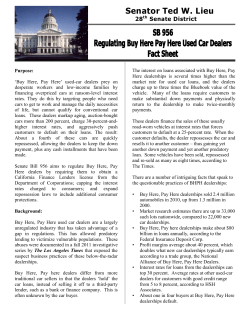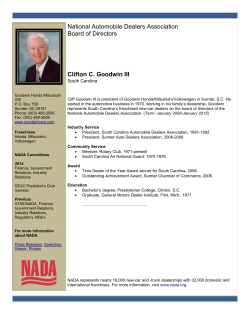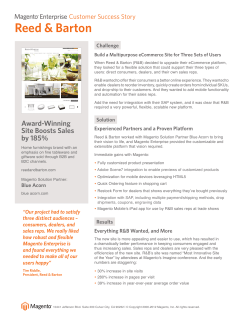
Lawn Mowers
Lawn Mowers Many dealers also offer items such as leaf blowers, snow blowers, tillers, chainsaws, and golf course maintenance equipment. Some even carry “powersports” equipment like snowmobiles or jet skis. Industry Overview Lawn and garden equipment dealers compete among themselves, of course, but lawn mower dealers also face competitive challenges from other types of retailers. Home improvement centers and mass merchants are particularly strong in this market. Some manufacturers even make equipment that’s sold exclusively at these outlets. (Those same manufacturers may also produce higher-priced and higher-quality equipment sold only at lawn equipment dealers and service centers.) The following chart illustrates the ways in which lawn and garden power equipment were distributed in 2002 (the latest year for which statistics are available from the Outdoor Power Equipment Institute, or OPEI, as of January 2007). Lawn and Garden Power Equipment U.S. Sales by Retail Distribution Channel Home improvement centers/ building supply retailers 17.8% General merchandisers/ hardware/auto chains 17.4% Specialized lawn and garden equipment retailers 30.3% Other - 11.8% Discount retailers (Target, Wal-Mart) 10.5% Wholesalers/distributors* 12.2% *This category includes direct sales to professional lawn and landscape services, and farm supply stores. Source: Outdoor Power Equipment Institute, "2002 Profile of the Outdoor Power Equipment Industry." Typically, lawn and garden equipment dealers carry a complete range of mowers, blowers, and chain saws for residential and commercial use. Their primary products are walk-behind mowers; riding vehicles (mowers, lawn tractors, and garden tractors); and hand-held items like trimmers and brush cutters. The commercial customers who buy lawn and garden equipment from dealers are typically small and midsized accounts (such as lawn-maintenance operations, property managers, and golf courses, among others). Larger commercial users pay wholesale for equipment from distributors or even buy direct from manufacturers. Issues and Trends Lawn and garden power tools and equipment sales reached an estimated $9 billion in 2006. Industry revenue is dependent on two major factors: housing sales and new-construction starts, and the weather. With the housing boom officially over and the weather always unpredictable, many lawn mower and garden equipment dealers ended 2006 with left-over inventory of Model Year (MY) 2006 units. (Model Year in the industry is from September to August.) According to Appliance magazine (January 2007), two words describe the outdoor power equipment industry: cautious optimism. Revenue dipped in 2006 and is expected to stall in 2007, with a rebound forecast for 2008 (Appliance magazine, January 2007). These results follow two years of growth (2004 and 2005), driven by the strength in the economy generally and the housing sector specifically. Additionally, new-product innovations like zero-turn mower systems and strong market expansion by home improvement retailers also helped drive growth (Mintel International Group, Ltd., “Lawn and Garden - U.S.,” September 1, 2005, “Lawn and Garden Power Tools,” October 1, 2005). Since consumers don’t often need to replace their mowers and trimmers because of wear and tear, industry growth is powered instead by innovation and new design features that increase the performance of these tools. Demographics play a part, too: aging consumers will require lawn and garden power equipment that is lighter and simpler to use. And some equipment redesign will be necessary to accommodate the growing number of women who operate these tools (Mintel International Group, Ltd.) © 2007 Profile America, Inc. All rights reserved. www.profileamericabiz The hand-held product group (hand-held and backpack leaf blowers, trimmers, and chainsaws) held its own in 2006 but may exhibit some unsteadiness in 2007, with recovery predicted in 2008. Record increases in these units were realized in 2005, when shipments of backpack leaf blowers increased by 23.9% and handheld leaf blowers increased 10%, so a softening is understandable given that there are so many relatively new models in customers’ hands. Similarly, shipments of consumer lawn mowers fell in 2006. “Walk-behind” mowers fell by 6%, to around 6 million units, and shipments of consumer riding lawn mowers fell by more than 8%, according to the Outdoor Power Equipment Institute’s estimates (Appliance, January 2007). Though not expected to show quite as steep a decline, 2007 is also expected to be a difficult year for many lawn mower dealers, with industry-wide revenue expected to slip by around 2% to 3%. Recovery is expected in 2008, when shipments will grow by around 4%. Despite the forecast for a drop in industry revenue, some dealers are expected to weather the forecast well. Power equipment dealers who outperform the industry will likely be those in still-hot housing markets, in regions where the Spring and Summer growing seasons are long, and in affluent areas where commercial customers stay active most of the year servicing residential lawns and gardens (Power Equipment Trade magazine, January/February 2007). Among dealers in all areas who will ring up sales increases in 2007 are those who “go the extra mile” in planning and executing advertising, marketing, and customer-satisfaction programs. Lawn equipment industry leaders generally believe that the industry will remain viable in most regions, despite radical weather conditions (drought in some places, extreme rain amounts in others) and slumping sales in certain product categories. Among the opportunities for growth, amid the competition from “big box” stores that offer less expensive products, are the following: Opportunities for Growth . . . U.S. Shipments of Walk-Behind Mowers 8 7 6 • A growing number of dealers are making their operations more profitable by simplifying them. They’re shedding product lines where the time and resources spent on managing vendors doesn’t justify the financial return. • Ongoing consolidation among product distributors in the industry will create stronger competition (among distributors) for dealers to carry their lines. The end result will be that dealers will have more and better product choices, and more opportunities to take advantage of education and training programs and customer-service initiatives. • The reward is greater than the risk for dealers who actively seek partnerships with suppliers in developing new-business opportunities. By so doing, they can often persuade manufacturers to send less business to their big-box competitors. • Focusing on the WOW! factor helps increase the WOM factor (word-of-mouth). Creating large, welllit window displays attracts attention, and adding bold, colorful, and even animated displays to the showroom helps keep people “engaged” while browsing in the store. The idea is to impress them and encourage them to tell friends and neighbors. • Product demonstrations and seminars help establish the dealership as a “go-to” source for expertise in the operation, maintenance, and repair of equipment -- which mass merchants cannot offer. • Dealers who take full advantage of co-op advertising dollars available from manufacturers in essence double their advertising and marketing budgets. While it takes a bit of time and attention to organize and execute ads and campaigns using co-op dollars, it is typically well worth the effort to align with brand-name manufacturers. 2000 to 2006 (In Millions) 6.2 5.6 5.8 6.0 6.2 6.4 6.0 5 4 3 2 1 0 2000 2001 2002 2003 2004 2005 2006 Sources: Outdoor Power Equipment Institute (OPEI) Press Releases, March 2006, January 2006, Septmber 2005; “2002 Profile of the Outdoor Equipment Industry”; Appliance, January 2007. U.S. Shipments of Riding Mowers 2000 to 2006 (In Millions) 1.8 2.0 1.5 1.5 1.5 1.3 1.3 1.5 1.4 1.0 0.5 0.0 2000 2001 2002 2003 2004 2005 2006 Source: Outdoor Power Equipment Institute (OPEI) Press Releases, March 2006, January 2006, Septmber 2005, “2002 Profile of the Outdoor Equipment Industry”; Appliance, January 2007. Source: Power Equipment Trade magazine, December 2006. © 2007 Profile America, Inc. All rights reserved. www.profileamerica.biz Consumer Reports on Buying Mowers • Factor in the add-ons. All the tractors come equipped to side-discharge clippings. While mulch kits are often included or relatively inexpensive (about $75), bagging often costs $300 to $400 extra. • Think twice about zero-turning. Zero-turn-radius mowers offer the tightest turns, but are expensive, and their front wheels can make steering a problem on hills. • Don’t count horses. Some models now pack 20 hp or more. Higher horsepower doesn’t guarantee more performance, however; models with as little as 17 hp mowed as well as brawnier models. • Pick the right retailer. Most of the brands tested are now at major retailers as well as specialty dealers. Big-box stores tend to have the lowest prices. But dealers typically offer more personalized service, setup, and instruction. • Decide how much power is necessary. Gaspowered mowers usually handle heavier-duty mowing better, like in tall or dense grass. Electric mowers have push-button start and no exhaust emissions, but come in push-only models. Selfpropelled mowers are best for hilly terrain and lawns bigger than a half acre. Sources: Consumer Reports, May 2006. With retail prices rising on commercial equipment (from $2,500 to $7,500 and more), demand for quality reconditioned equipment is growing. Many dealers realize that used equipment is unique (e.g., nobody else has the same make, model, amount of mileage, and service history of a pre-owned mower). Online selling of used mowers is an intriguing option, too. Ace Outdoor Hardware, of Bayville, New Jersey, is a pacesetter on the Internet, as it sells almost all of its used equipment on e-Bay and posts a real-time reference guide on e-Bay to tell prospective customers the current value of its used equipment (Outdoor Power Equipment, October 2005). Value of Products and Services in the Industry Consumer Research’s website provided the latest research and ratings (primarily from Consumer Reports), of the best products in certain lawn mower categories. They’re presented below, with average retail prices: Product Price Self-propelled gas Toro Super Recycler 20056 $580 Budget self-propelled motor: Toro Recycler 20070 $400 Gas-powered push motor: Craftsman 38894 $190 Electric Black & Decker 18 in. mower MM675 $210 Cordless lawn mower: Black & Decker CMM 1000 $430 Manual reel mower: Scotts Green Classic $130 Average household spending of $80.35 for lawn and garden equipment is calculated by dividing $9 billion in spending by 112 million households. Average spending is helpful in determining market potential and market share. For example, in an area of 40,000 households, it is safe to assume that $3.2 million is spent on lawn mowers and other outdoor equipment. If a dealer generated $600,000 in revenue, his or her market share would be 18.7%, a baseline against which future performance can be measured. Critical Success Factors Critical Success Factors • Sell products emphasizing not low prices, but the value-added intangibles like product demonstrations; explanations of the warranty coverage; after-the-sale follow-up; on-site service and repair, and lock-boxes for commercial customers to drop off and pick up items before or after hours. • Develop partnership relationships only with manufacturers that provide dealers with strong support in merchandising, training, marketing and promotions programs. • Build a website to satisfy the information needs of a growing number of people who conduct their product research online before visiting a store to purchase. Confidence Factors Mentioned In Ads “We Service What We Sell” Brand Name Affiliations Repairs Done on Premises Complete Parts Inventory Expert Lawn Advice Expert Repairs - All Brands Years at Same Location Guarantees / Warranties Winter Maintenance Authorized Sales Source: 2006 Comparative Ad Analysis Survey, Norbert J. Kuk & Associates. Convenience Factors Mentioned In Ads Website Address Location Data / Maps Pick-up and Delivery (Repairs) Size of Inventory Same-Day Service Open 6/7 Days a Week Winter Storage Parking Trade-Ins Accepted Financing Available Source: 2006 Comparative Ad Analysis Survey, Norbert J. Kuk & Associates. Sources: Profile America, Inc., interviews; Power Equipment Trade magazine, December 2006, January 2007. Industry Resources Outdoor Power Equipment Institute; www.opei.com Outdoor Power Equipment Magazine; www.greenmediaonline.com Consumer Reports; www.consumerreports.com Power Equipment Trade Magazine; www.poweret.com © 2007 Profile America, Inc. All rights reserved. www.profileamerica.biz Background Values and Benefits Media Marketing, Inc., creators of imMEDIAte® software, has been in the forefront of sales presentation systems since 1987. The imMEDIAte suite, a state-of-the-art consultative system, is used by hundreds of media reps every day to create compelling presentations and expert media proposals. Built on Microsoft Office® technology, the imMEDIAte system provides a complete solution to your media sales needs. Media Marketing is an authorized distributor of Profile America’s IndustryIQ reports. Sales and marketing teams embrace these industryknowledge reports because of their concise, easy-to-read style and rich store of information. Regular use of IndustryIQ reports creates a relationship-building, consultative environment. Since 1986, Profile America has provided profiles of industries, markets and trends to business-to-business marketers, facilitating an understanding of the industries into which they sell their products and services. Program Objectives IndustryIQ reports are used by managers as sales training, planning and business development tools. Sales reps use IndustryIQ reports to prepare for sales calls and as a valuable leave-behind. Armed with independent, third-party assessment of industry dynamics, media reps can “walk the walk and talk the talk” of their advertisers’ industries, allowing reps to better assist advertisers in creating compelling, effective messages for their target audiences. Sales reps want to be smart about advertisers’ industries, but face the realities of limited time and resources. They need to track dozens of different industries, and value these concise, easy-to-use sales tools that they can leave behind with their advertisers. Likewise, managers want reps to be confident, professional and informed. They want their reps viewed as partners, not vendors -- and they appreciate the IndustryIQ method of collecting, analyzing and presenting information. Independent, third-party IndustryIQ reports leave marketing and sales professionals free to practice their core competencies: developing successful advertising strategies for their clients. Delivery IndustryIQ reports incorporate a customer- guided approach to gathering information and creating industry-knowledge products. We value your content recommendations as we strive to create the most useful, fact-filled industry reports available. IndustryIQ reports are available in PDF format from Media Marketing’s web site, www.industryIQ.biz. IndustryIQ is distributed by Media Marketing, Inc., in association with Profile America, Inc., for use by advertising sales representatives. Although the information in this report has been obtained from sources that Profile America, Inc. believes to be reliable, no guarantees are made as to the accuracy of the information presented, and any information presented may be incomplete or condensed. © 2007 Profile America, Inc. All rights reserved. www.profileamerica.biz
© Copyright 2025





















